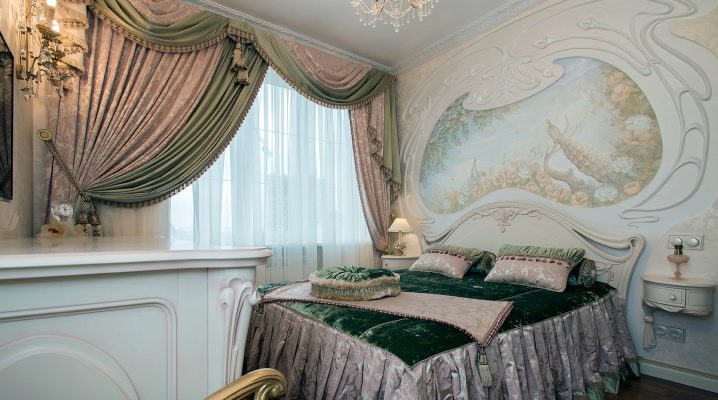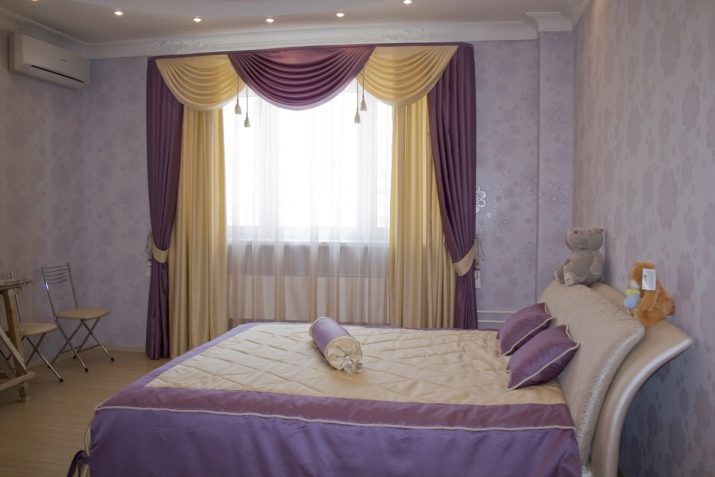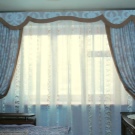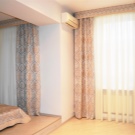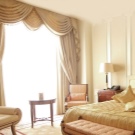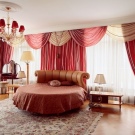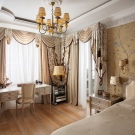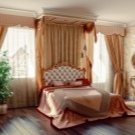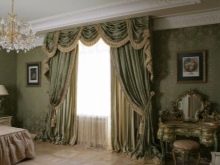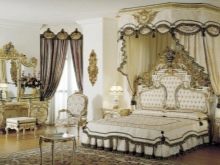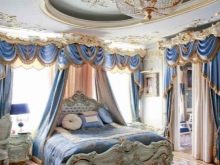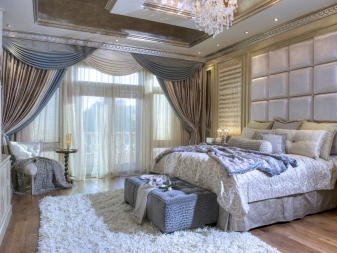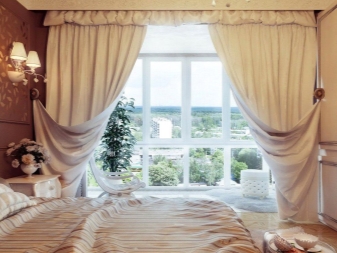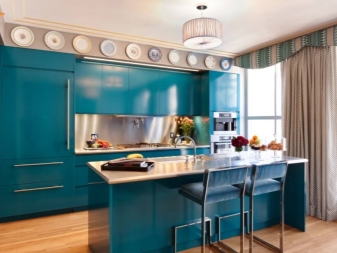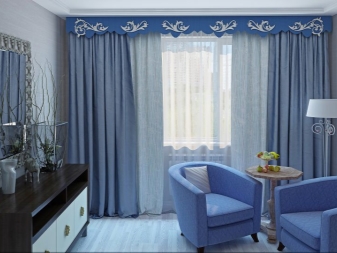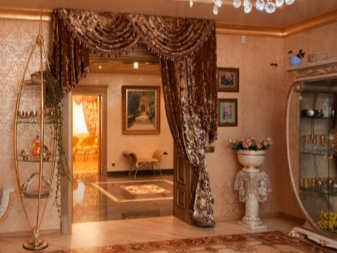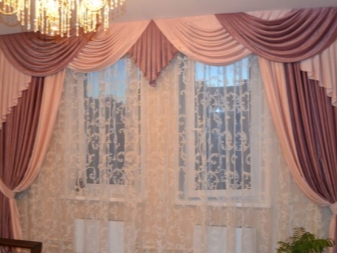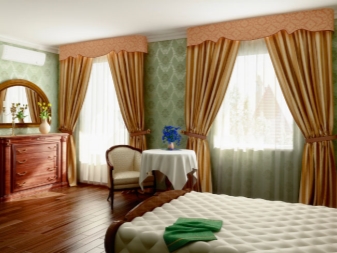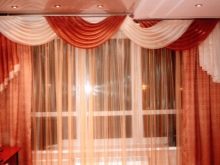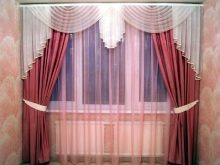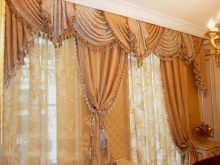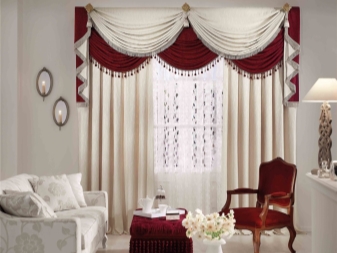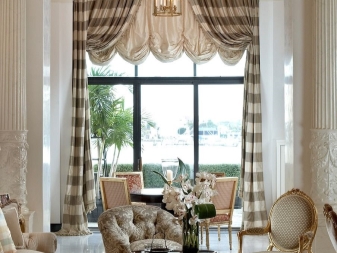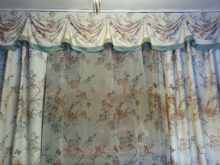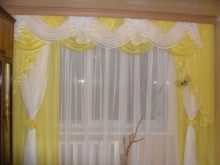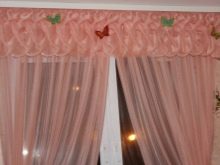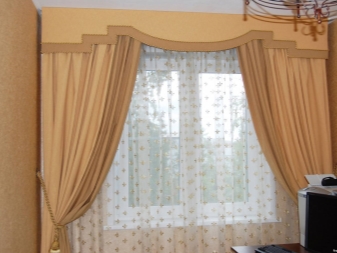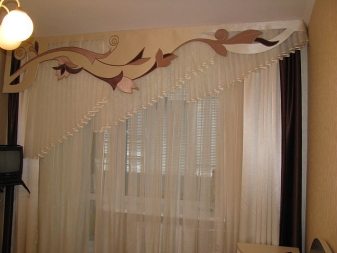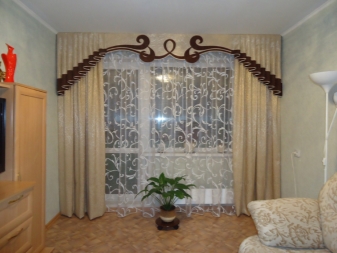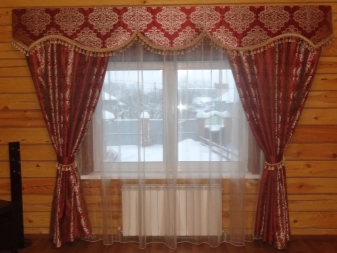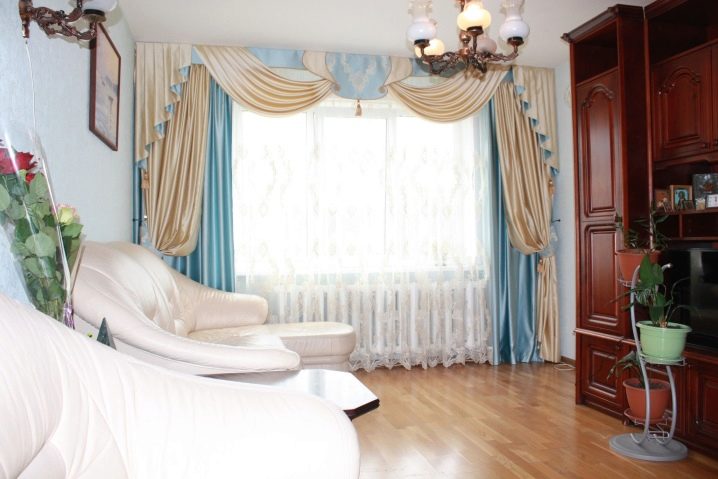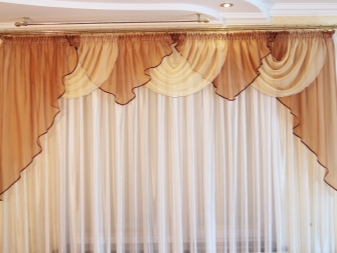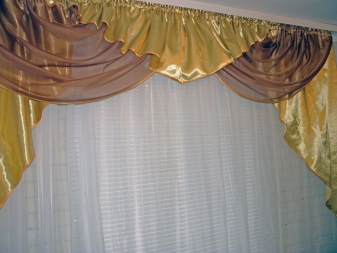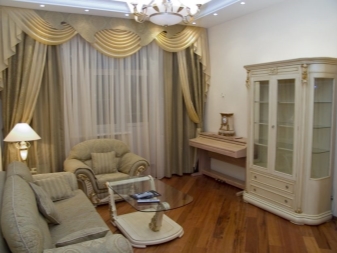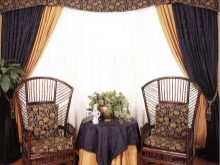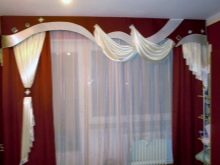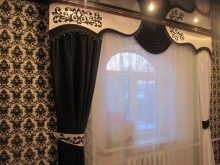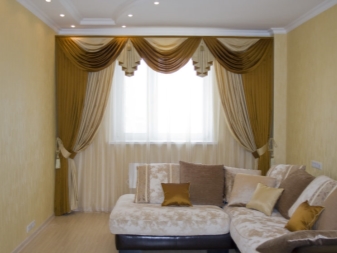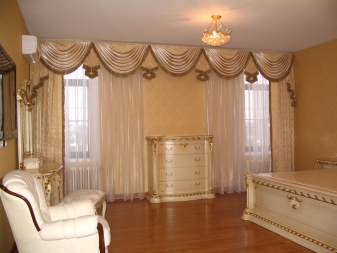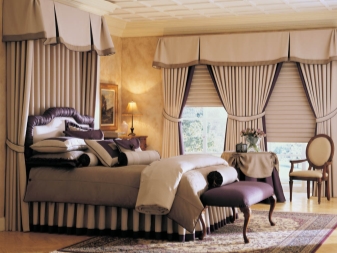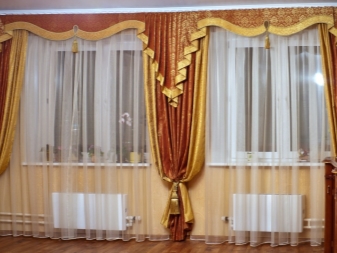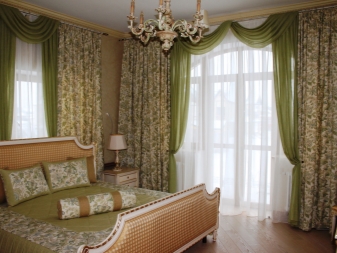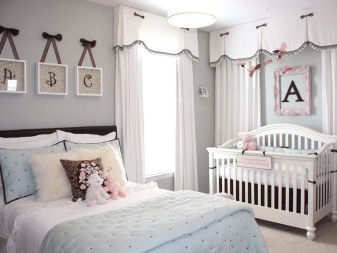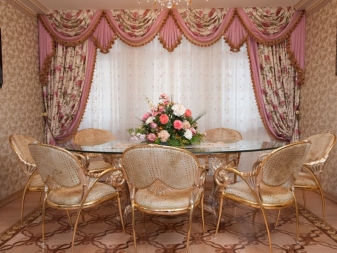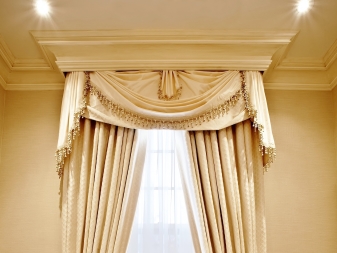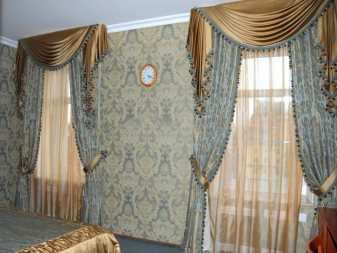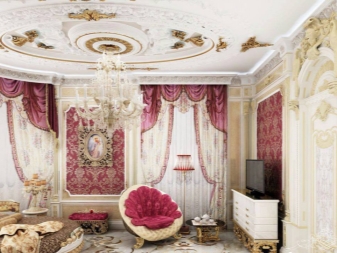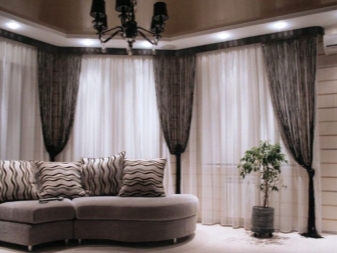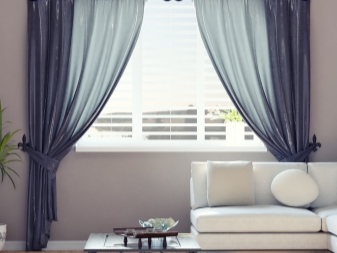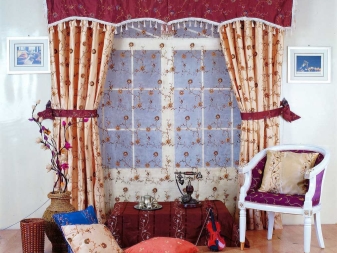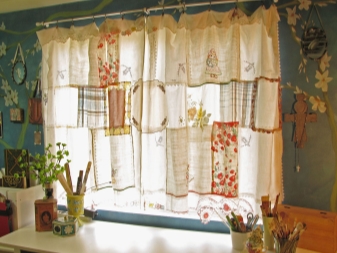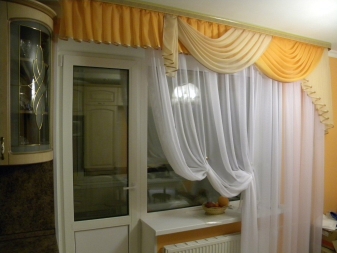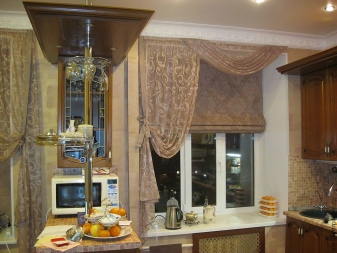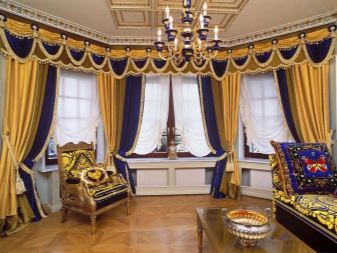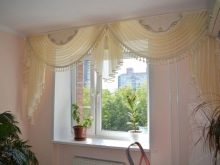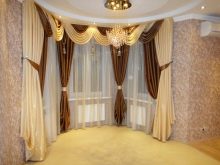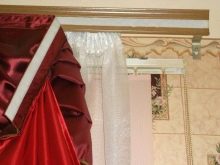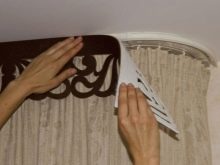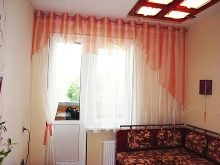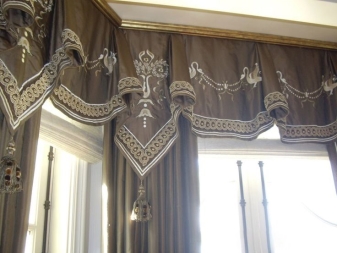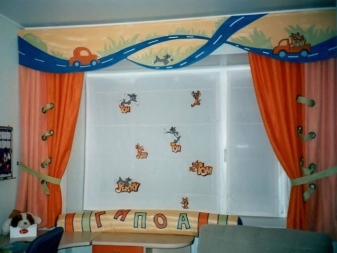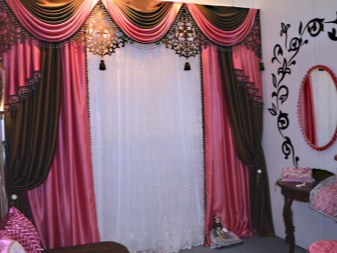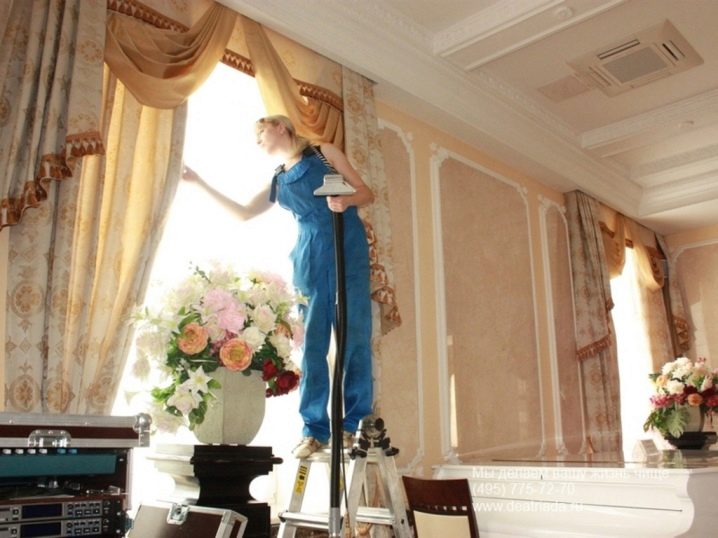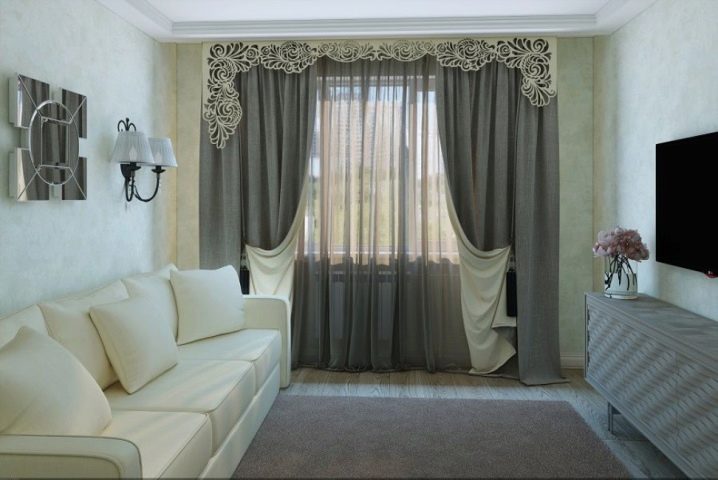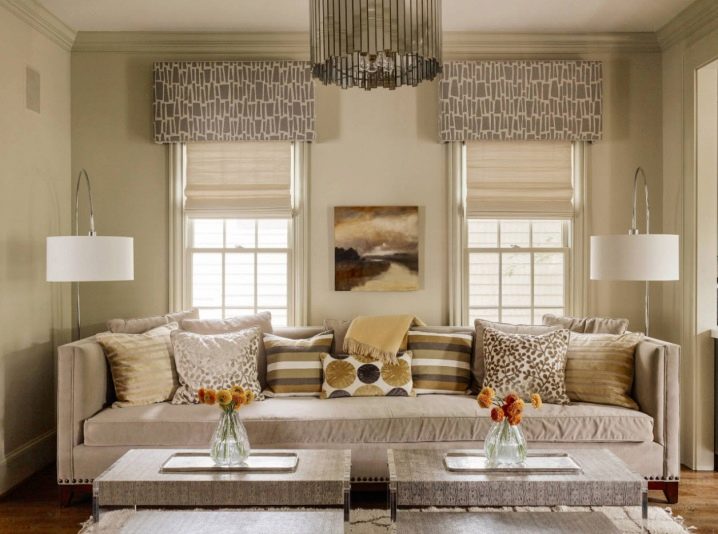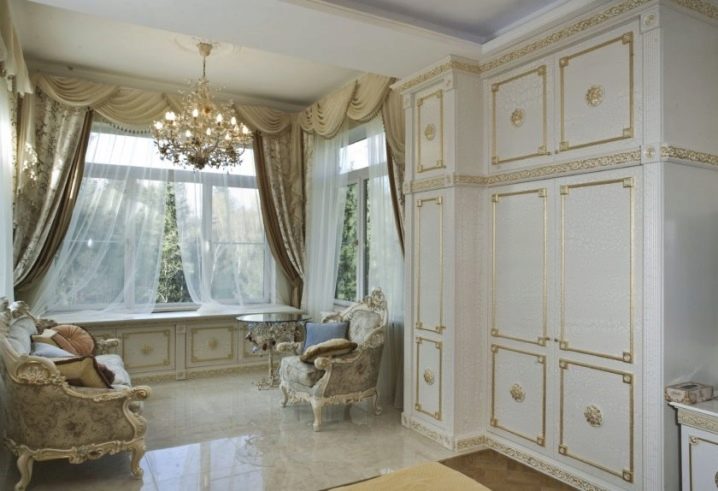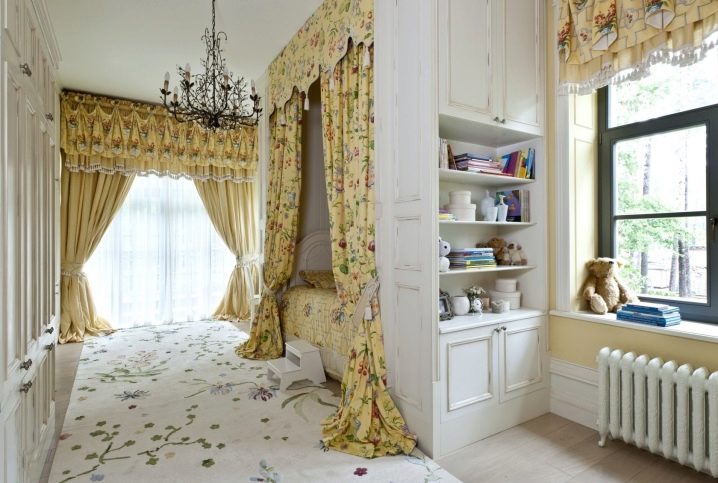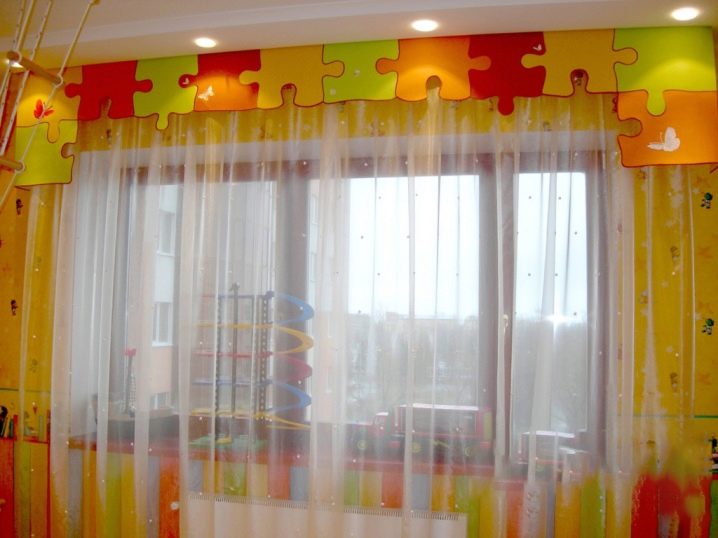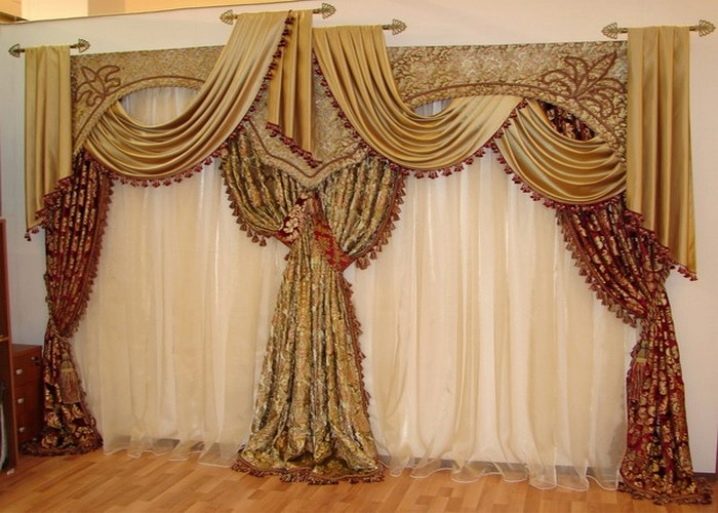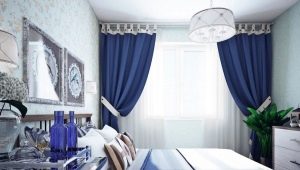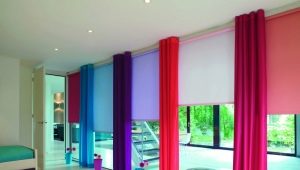All variety of lambrequins
The fashion for lambrequins is back with the desire of people to live beautifully. The huge choice of these decorative elements opens a space for imagination in creation of an original interior.
What it is?
Lambrequins are decorative elements that adorn the upper edge of curtains. The idea of such a decor was born in the XV century. It was then that people thought about how to better disguise the eaves and the space above the window opening. Lambrequin then carried a protective function, protecting the room from drafts.
The wide wooden carved eaves became the ancestor of the modern lambrequin.
The creation of lambrequins reached its peak by the 16th century. Baroque style erected their use in the cult. Designers offered all new and new ideas for the design of lambrequins. At the same time, special ways of draping appeared. The sophistication of the window design and design of the curtains in general spoke about the wealth and well-being of the owners of the house.
When Rococo came to replace the Baroque, lambrequins became the main element of window decoration. The curtains were made less sophisticated and ornate, and lambrequins, on the contrary, were full of various details of decoration. Expensive fabrics decorated with sewing, fringe, and gilding framed the windows of the royal palace and the palace hall.
Today, from time to time new ideas arise in the design of this interesting element. Now lambrequins are not only a hallmark of classical palace styles, there are models for Modern, Hi-tech and even Minimalism. Lambrequins of various colors are made, with and without decor, for small and large rooms, for high ceilings and not so for children’s, bedrooms, kitchens - there is a huge variety of options for today.
Lambrequin can decorate not only the window. This design doorway or bed is quite common, with the manufacturing technology used is the same as the set of components. The difference lies only in the functional purpose.
Kinds
All lambrequins can be divided into two large groups:
- Soft;
- Hard.
TO soft include models made from fabrics of various kinds. Both thick curtain fabrics and light tulle fabrics are used. They are combined with each other and laid in the form of various elements:
- The most common are swagthat look like semicircular cuts of fabric, laid in soft folds. Usually, the swagas are not made very deep and are arranged in pairs or triples on the eaves.
- Polusvagi, or perekida, serve as asymmetric alternative to arcuate "namesake". Especially effectively they look at the design of tubular curtain rods, but this does not mean that they do not make them under the baguette cornice. Just in this case, the main feature of pericides is lost, namely the ability to transfer fabric through the eaves.
- Kokilje hangs in the middle of the curtains and is the semantic center of the entire composition of the pelmet. It is a fabric gathered in an acute angle by folds to each other or from each other. Kokilye often hangs over the frames of each of the windows when designing a lambrequin, combining several windows at once. This technique allows you to conditionally divide the window gaps.
- Jabot (de jabot) - side wide element with beveled edge.It is installed at the corners of the eaves and is the final touch when creating a pelmet. Usually the long side of jabot is placed outside, and the short side is in the middle. De jabot draped overlapping folds located across the entire width of the canvas.
- Tie - similar side element. Unlike jabot, it is not so wide. Tie folds are located one above the other. The beveled edge at the same time allows you to create an interesting spiral effect. The short side is located outside, and the long side is close to the curtains.
- Bell can not be called a common element today. It is a piece of fabric, folded in the shape of a cone. It is beautiful when the fabric at the same time has a contrast lining. Bells are formed only from sufficiently dense elastic materials, they cannot be created from tulle.
- Scallop - horizontal folds on lambrequin. The entire canvas is laid out in semicircular folds-tucks, excellent both in technology and in appearance from Svagi. This type of drapery is only suitable for rooms with very high ceilings, as the lambrequin in this case should be quite wide.
- Puffs - A special way nabborennaya fabric, which resembles weaving-pigtail. This technique allows you to "simplify" the majestic appearance of the pelmets, helps in giving a rustic style to curtains.
Hard Lambrequins performed in two ways. In the first case, the material is stretched on a wooden frame. Such gangs have spread in the classic interior.
In more modern versions, the fabric is attached to a dense material (for example, non-woven fabric), which was previously given the desired shape. They are called soft-lined gangs.
Kinds:
- Hard lambrequins are with straight or shaped bottom edge. The choice of one or another type depends on the particular style of the room.
- Also recently received such a subspecies as tracery bando. It is usually performed using laser cutting in the factory. This allows you to apply a thin openwork pattern, while making the edge very smooth, and the lace is thoroughly accurate. Sometimes openwork lambrequins are made at home using the guilloche technique or each of the “lace” cuts is handled manually.
Some experts also distinguish such a view as combined lambrequins. There is both a hard gang and a soft lambrequin at the same time, and they can even intertwine with each other (for example, when the transfer is passed through a decorative hole in an openwork gang).
Materials
If we talk about fabrics, most often lambrequins are made from a veil or from organza. Lightweight material drapes perfectly, allowing you to create intricate decorations that look weightless, thereby making the space around more airy.
Also, a soft version can be made of drape fabric, while it is important that it be elastic and well yielded to drapery. Atlas, jacquard, taffeta, velor, silk, velvet are perfect for this purpose.
You can often notice a combination of different density materials when creating lambrequins. Indeed, such a move has the right to exist, but you need to remember some rules.
- Dense fabric is chosen the same from which the curtains were made.
- The bottom layer should always be dense material, and translucent svagas and jabots are layered on top of it.
The soft frame for a hard gang is made from a thick bulk fabric, for example, from felt or dublerin.
As a material for tight hard bando usually choose polyester dense texture. Natural fabrics are not used, as they may be difficult to clean. If the lambrequin is made on a soft base, wet cleaning is contraindicated in it, unlike models on a wooden frame.
The solid lambrequin is also supplied with a velcro, so that it is convenient to attach it to the eaves.
The choice of fabric with a pattern is possible, if we are not talking about the decoration of an openwork band. It should be made of a single-color fabric or a fabric with a gradient.
Dimensions
With the width of the lambrequin, everything is simple, it is not limited by anything. If the owners of the premises want, they can hang up and 4-meter lambrequins. However, with length everything is a little different.
Guided by the rule of the golden section, designers many years ago proclaimed the axiom that the pelmet should not occupy more than 20% of the window space. The rule is relevant to this day regardless of how high the ceiling in the visit. On the contrary, it is believed that the lower the ceiling, the already should be designed lambrequin.
The width of the jabot or gastukuks should be about one and a half meters, not wider.The listed elements, as well as the metal molds, should not descend below the middle of the window, otherwise they will look extremely ridiculous. A suitable width for them is about a third of the width of the entire window opening.
Colors
The most fashionable shades include:
- The whole range of brown tones, ranging from light beige and ending with a rich chocolate;
- White;
- Purple;
- Gray blue;
- Muffled green;
- Gold;
- Lilac.
Choosing color of lambrequins, be guided by the general color palette of the room and curtains. Sometimes it is appropriate to hang a gang of a contrasting color, and sometimes you should opt for related combinations.
If the curtains are made of fabric with a pattern, a suitable option would be to opt for a combination of soft lambrequins. Svagi must be made from the dense fabric of which the curtain is made, and from the light veil chosen as curtains. Such a finish looks appropriate and stylish, regardless of the color combination of elements.
In recent years, finishing on the edge of the lambrequin is gaining popularity. As the colors of the finish fit the classic colors: white, gold.Choosing a color finish, you can accidentally make a mistake and the whole impression of the room will be spoiled at the moment when the viewer will pay attention to the upper part of the curtains.
Styles
Modern styles, like classical traditional ones, veto some elements of decoration. On each of the popular style should be a little more detail:
- Baroque opens the list, because there is a lot of attention paid to lambrequins. Choose models of porter fabric of light colors, trimmed with gilded fringe. It will also look good combination of soft and rigid structures.
- Design Rococo in many similar to the Baroque, but here it is already possible to use the average in saturation shades. Buying too dark curtains and lambrequins is unacceptable. Finishing should be done with gilded fringe or a gang left completely without decor, the main focus is on fabric. Asymmetry of forms is welcomed: choosing an asymmetrical jump to the fold, you will not lose.
- For style High tech It is permissible to use rigid structures. The use of soft lambrequins is inappropriate here.You should choose a straight lambrequin of the same fabric as the main curtains.
- AT minimalistic the interiors can only use openwork lambrequins, the pattern in which are industrial themes. Basically, the use of lambrequins is not typical for this subject. The same can be said about style Modern.
- Retro the style prescribes the installation of simple lambrequins with rings attached to the tubular cornice. Choose fabrics with a rustic-style ornament: large flowers, peas, abstract patterns. Puffs are welcome at the design of the upper edge.
- Framing the window in style Chebbi chic, look at the models with the application. Well, if she will imitate ribbon embroidery. The same rule applies to stylistics. Boho chic. Also do not forget about the riot of colors characteristic of Boho. When choosing a fabric, by all means pay attention to the color of the canvas.
In different rooms
Designers are guided by the following principles:
- Choosing a pelmet in the hall or living room it should be remembered that this room is the “mirror” of the house. Guests will evaluate your home exactly the situation in this room.Therefore, for the design of windows fit sophisticated lambrequin designs. Well, if you combine hard and soft options: it gives more opportunities for design.
- When making windows with balcony door Pay attention to asymmetric models that allow you to visually balance the proportions of the window opening. Soft jabot on the opposite end of the door curtains are perfect for this.
- For the hallway as for the kitchen, sometimes it is enough to hang one transfer, complementing it with a roller blind or horizontal blinds. The room will be transformed immediately, it will become cozier, while it will not look vulgar and flashy.
- When choosing lambrequins for bedroom An excellent choice would be a combination of hard gangs and soft swagas. This option will add comfort, give the room an atmosphere of security. Labrekens will protect from drafts and it will become more comfortable to sleep in this room.
How to choose?
Professional Tips:
- When choosing suitable models for a small window, keep in mind that the pelmet should not affect the opening. It is best if it is located above the window, completely leaving the frame open.This technique helps to visually increase the area of the window and it will seem larger.
- The most suitable options for a narrow window are the intricate wide lambrequins covering the upper border with the pier. Folded pelmet here more than appropriate, especially if the height of the ceiling allows.
- For small "Khrushchev" with low ceilings, you should choose rigid flat models that allow you to visually add a few centimeters to the height of the room.
- Beautiful lambrequins into two windows must be separated in the middle. This will visually enlarge the room as well as demarcate it.
- For bay windows, only soft frames should be selected and no hard bando should be abandoned. It is good if the lambrequin material is two-sided: you can use the decorative element bell, which looks great with arcuate designs.
- Perekida in the kitchen, you can sew from the remnants of the fabric after sewing curtains in the bedroom, for example. So you will save money and at the same time use good matter in the household. Often, natural materials are selected for the bedroom, so to complete the picture you can make towels and potholders,which will perfectly harmonize with the new semi-woven on the kitchen window.
How to attach?
Fastening technologies are as follows:
- Lambrequins on the windows, as already mentioned, are divided into hard and soft. Hard usually fasten with velcro directly to the eaves. At the moment it is the most convenient option.
- Soft lambrequins are often made on one side. In this case, they require a retainer that will fix the position of jabot and will not allow him to "leave." The same applies to the flip-flop models: one part of them is fixed, and the other just pounces over the eaves.
- Interesting mounting options on the grommet. They are also used with a tubular cornice, allowing you to instantly draw attention to this part of the window.
What to decorate?
There are lots of ways to finish, but the most popular ones are fringe, embroidery, photo printing and appliqués:
- Fringe It is perfectly combined with swagami. Choose white, golden elements. As a rule, they are suitable for any design curtains.
- An interesting effect can be achieved if you hang brushes with bells-cones. Simply arrange them so that they “peek out” from the bell.
- Photo printing looks great in the nursery on the fabric of a hard gang. Placing various scenes from cartoons, illustrations with animals, pictures of machines or colors, you can please your child, while at the same time stylishly decorating the space.
- Embroidery used mainly in rustic interiors. The edges of the lambrequin are sheathed with lace, which is subsequently duplicated in the design of the pickups.
How to wash?
In the washing machine the lambrequins cannot be washed, but this does not mean that they cannot be cleaned at home. Best for this purpose suitable vacuum cleaner. Turning on the minimum power and wrapping the pipe with a wet gauze, carefully "walk" through the folds of the pelmets, collecting dust. Since it is high, it is usually not heavily polluted.
From time to time it is necessary to carry lambrequins and a gang into the dry-cleaner in order to prevent dirt from entering the material.
How to stroke?
It is not necessary to remove it to stroke. Just use the steamer directly on the weight, gently applying hot steam to the fabric. As a rule, dents will be straightened, and the necessary folds will remain and even will be fixed.
Options in the interior
In this photo gallery you can find fashionable variants of lambrequins, novelties in this market and timeless classics:
- Fashionable openwork lambrequins perfectly complement the design of the living room. The unobtrusive milky white color is in harmony with the overall decor of the room, as well as with the curtains (look at the wrong side). Light asymmetry makes an already interesting gang even better.
- The hall in retro-style is complemented by flat rigid gangs on a wooden frame, made of fabric with a pattern. Despite the fact that the fabric is nowhere else in the interior is duplicated, it fits perfectly thanks to well-chosen shades.
- Soft swags, decorated with fringe, add even more luxury to the decoration of the halls in the Baroque style. Heavy lightweight fabrics look good and expensive. Lambrequins are not matched to the color of the curtains, but to the color of the walls, however this move allowed to add space to the room.
- Different types of lambrequins are used here. Soft poufs were chosen for the window, and a rigid gang was used to frame the bed. A soft lambrequin, which is made of the same fabric as the curtains above the bed, helps to tie these two decorations together.
- An interesting band of felt is a great solution when you need to simultaneously mask and insulate the area between the wall and the opening. The cheerful design will not leave the kids indifferent, and the bright colors make this detail of the interior its semantic accent. Butterfly decals complete the picture, acting as a suitable decor in this situation.
- This is how complex combinations of hard and soft lambrequins look like. To create a truly beautiful design is possible only for an experienced craftsman who has impeccable flair and understanding of style. Various interesting cornices, finishing options in the form of pickups or patterns on a gang and fabric of such a complex shade are very difficult to combine with each other.
Lambrequins can also be sewn with your own hands. See how to do this in the next video.
